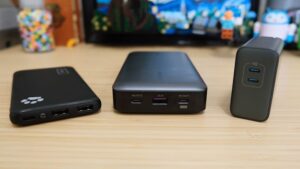Looking for a quick and easy solution on how to charge your power bank portable charger? Well, you’re in luck! In this blog article, we’ll walk you through the simple steps to ensure your power bank is always ready to keep your devices juiced up on the go. Whether you’re a frequent traveler, a busy professional, or simply someone who relies heavily on their electronic devices, knowing how to charge a power bank portable charger is an essential skill. So, let’s dive right in and demystify the process, shall we?
How to Charge a Power Bank Portable Charger
Power bank portable chargers have become an essential accessory in our tech-savvy lives. These handy devices allow us to charge our smartphones, tablets, and other gadgets on the go, ensuring that we never run out of battery power when we need it the most. However, it’s crucial to understand how to charge a power bank properly to maximize its performance and ensure its longevity. In this comprehensive guide, we will walk you through the steps of charging a power bank portable charger and provide useful tips and insights along the way.
Choosing the Right Power Adapter
Before diving into the charging process, it’s essential to select the right power adapter to avoid any compatibility issues or potential damage to your power bank. Here’s what you need to know:
- Check the power bank’s specifications: Look for the recommended input voltage and current on the power bank itself or in its user manual.
- Choose a compatible power adapter: Select a power adapter that matches the recommended input voltage and provides sufficient current output. It’s generally advisable to use the original power adapter that came with your power bank. If you need to replace it, make sure to choose a reliable and reputable brand.
- Consider the charging speed: If you want to charge your power bank faster, opt for a power adapter with a higher current output. However, be cautious not to exceed the manufacturer’s recommended input current to avoid potential overheating or damage.
Charging Process
Now that you have the right power adapter, let’s move on to the step-by-step charging process for your power bank portable charger:
Step 1: Plug in the Power Adapter
Connect the power adapter to a wall socket or a reliable power source. Ensure that the power source is in good condition and provides a stable electricity supply. A surge protector can be a valuable investment to protect your power bank from voltage fluctuations and power surges.
Step 2: Connect the Power Bank to the Adapter
Connect one end of the charging cable (usually a USB cable) to the power adapter, and the other end to the input port of your power bank. Make sure the connection is secure and firm.
Step 3: Power Bank Status
Check the power bank’s LED indicators or display screen, if available, to verify its current battery status. Some power banks have multiple LED lights, each representing a specific battery level or charging status.
- If your power bank has a digital display, it may show the battery percentage or an estimated charging time remaining.
- If it has LED lights, the number of lit LEDs typically indicates the current battery level, e.g., four lit LEDs might represent 75-100% battery capacity.
Step 4: Charging Time
The time required to charge a power bank depends on various factors, including its capacity, the charging current, and the remaining battery level. As a general rule of thumb, smaller power banks (e.g., 2000mAh) may take around 2-4 hours to charge fully, while larger ones (e.g., 10,000mAh) can take 8-12 hours or more.
Keep in mind that some power banks support fast charging technology, allowing them to recharge at a significantly faster rate. If your power bank supports this feature and your power adapter is compatible, you can enjoy a quicker charging experience.
Step 5: Unplug and Store
Once the power bank is fully charged, unplug the charging cable from both the power adapter and the power bank itself. Safely store the power bank in a cool and dry place until you need it.
Charging Tips and Best Practices
To ensure the optimal performance and longevity of your power bank portable charger, consider following these tips:
- Read the User Manual: Always refer to the user manual provided by the manufacturer for specific charging instructions and any additional precautions.
- Avoid Overcharging: Overcharging can potentially harm the battery life of your power bank. Once it reaches full capacity, unplug it from the power source promptly.
- Avoid Extreme Temperatures: High temperatures can degrade the battery’s performance, while extremely low temperatures may temporarily reduce its capacity. Store and charge your power bank within the recommended temperature range specified by the manufacturer.
- Use a High-Quality Cable: Invest in a reliable and high-quality charging cable to ensure efficient power transfer and reduce the risk of overheating or damage.
- Charge Regularly: Even if you don’t use your power bank frequently, it’s advisable to charge it periodically (e.g., every three months) to maintain its battery health.
- Avoid Depleting the Power Bank Completely: It’s generally recommended to avoid fully discharging your power bank before recharging it. Instead, aim to recharge it once it reaches around 20-30% capacity to prolong its battery life.
By following these charging tips and best practices, you can ensure that your power bank portable charger remains reliable and efficient for an extended period.
Charging your power bank portable charger correctly is crucial to its performance and longevity. By selecting the right power adapter, following the step-by-step charging process, and implementing best practices, you can maximize the battery life and efficiency of your power bank. Remember to refer to the user manual provided by the manufacturer for any specific instructions or precautions. With proper care, your power bank will always be ready to provide a convenient and reliable power backup whenever you need it.
Frequently Asked Questions
How do I charge a power bank portable charger?
To charge a power bank portable charger, follow these steps:
- Locate the input port on the power bank. It is usually labeled as “input” or “IN.”
- Connect one end of the included charging cable (usually USB-A or USB-C) to the power bank’s input port.
- Plug the other end of the charging cable into a compatible power source, such as a wall adapter or a computer’s USB port.
- Check if the power bank has an indicator light. It may start blinking or turn on to indicate that it is charging.
- Leave the power bank connected to the power source until it is fully charged. The charging time may vary depending on the power bank’s capacity.
- Once fully charged, disconnect the charging cable from the power bank.
Can I use any charging cable to charge a power bank portable charger?
No, you need to use the charging cable provided with the power bank or a cable that is compatible with its input port. Using an incompatible cable may result in slow charging or may not work at all. It is recommended to use the original cable or a cable specifically designed for charging power banks.
How long does it take to charge a power bank portable charger?
The charging time for a power bank portable charger depends on its capacity and the power source you are using to charge it. Generally, it can take anywhere from a few hours to several hours to fully charge a power bank. Refer to the user manual or product specifications of your power bank for more accurate information on charging times.
Can I charge my devices while the power bank is being charged?
Yes, some power banks support pass-through charging, which means you can charge both the power bank and connected devices simultaneously. However, not all power banks have this feature, so it is essential to check the product specifications or user manual to confirm if your power bank supports pass-through charging. If it does not support pass-through charging, it is recommended to charge the power bank fully before using it to charge other devices.
Why is my power bank not charging?
If your power bank is not charging, you can troubleshoot the issue with the following steps:
- Check if the charging cable is securely connected to both the power bank and the power source.
- Ensure that the power source you are using is working correctly by connecting a different device or charger to it.
- If your power bank has multiple input ports, try using a different port to see if that resolves the issue.
- Try using a different charging cable to verify if the issue is with the cable.
- If none of the above steps work, there may be a problem with the power bank itself. Contact the manufacturer or refer to the product warranty for further assistance.
Final Thoughts
In conclusion, charging a power bank portable charger is a straightforward process. To begin, locate the charging port on the power bank and connect the charging cable. Ensure that the other end of the cable is inserted into a power source, such as a wall outlet or a computer’s USB port. Once connected, the power bank will start charging automatically. It is important to allow sufficient time for the power bank to fully charge, which typically takes a few hours. Once the power bank is charged, it can be used to charge various electronic devices on the go. So, if you’re wondering how to charge a power bank portable charger, simply follow these steps for a hassle-free charging experience.



